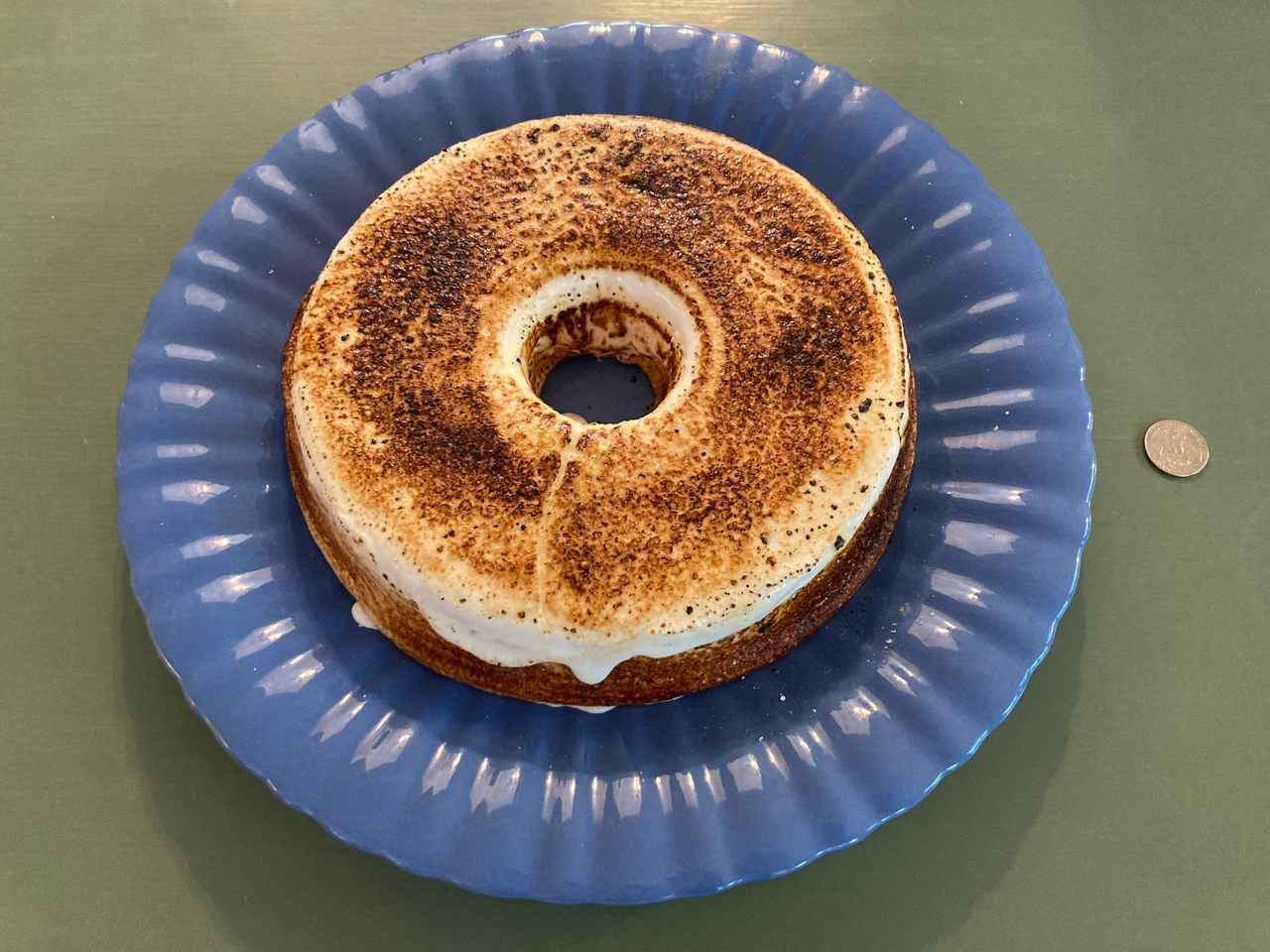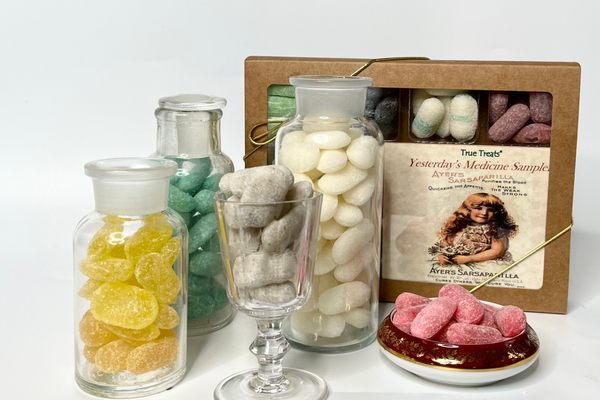Making a Massive Marshmallow, a Giant Chicken Nugget, and More
Feast on a Dorito bigger than your head.
THIS ARTICLE IS ADAPTED FROM THE MAY 11, 2024, EDITION OF GASTRO OBSCURA’S FAVORITE THINGS NEWSLETTER. YOU CAN SIGN UP HERE.
On social media, I’ve watched a lot of videos of people making tiny food. There’s something about seeing a person crafting a mini plate of pancakes or a petite hamburger that scratches some part of the human brain. But I’ve always been even more fascinated by extremely large food.
I’m not talking about food challenges at restaurants, where eating a vat of ramen or consuming a whole bucket of fried chicken will get you a prize or a free dinner. No, I’m talking about spectacles like when a community gets together to make an enormous omelet, or the time in 2009 when the food design and marketing group Bompas and Parr made 25,000 servings of punch and sent guests across a gargantuan punchbowl in a boat.
Historically, humans have loved making huge food, whether as a treat for a crowd to share or simply for shock and awe. The Bompas and Parr punch was actually based off of a historical event, when, in 1694, a British admiral wasn’t allowed to go home for the holidays. In revenge, he threw a Christmas party with military money that included a fountain of punch stirred by a child in a rowboat. In 1962, the Seattle World’s Fair unveiled a birthday cake for the fictional giant Paul Bunyan that weighed 25,000 pounds. Visitors could take home slices as souvenirs.
I don’t have the kitchen or the funds to whip up four tons of punch, but recently I was reminded of an old social media post where someone mused that the word Dorito implied the existence of a much larger chip called the Doro, because in Spanish the suffix -ito implies that something is small.
That got me thinking: What if I could make a Doro—and other large versions of very small foods? I solicited all kinds of ideas from my coworkers and friends. One person suggested making a large version of a cupcake (in other words, a regular cake). Someone else suggested a large gummy bear, but I didn’t feel like going out and buying a super-sized gummy bear mold. What else could I use it for, after all?
In the end I decided on making an enormous Dorito, a massive chicken nugget, and, for dessert, a huge marshmallow. These three projects required a lot of creativity, special ingredients, and, in the case of the marshmallow, a ton of patience.
Behold, the Doro

The Dorito is often held up as the ultimate processed food: unhealthy, but engineered through flavor, texture, and shape to be addictive to the extreme. While the colorfully orange nacho flavor is considered the standard Dorito today, Frito-Lay first released it as a plain corn chip in 1966. The company debuted the nacho flavor in 1972 and Cool Ranch in 1986.
For my own version, I started with a 12-inch flour tortilla. I had considered sitting down and making my own massive corn chip out of Fritos by crushing them, making them into a triangular patty, and frying that, but honestly, buying burrito-sized flour tortillas was just easier.
I carefully cut the tortilla into a triangle shape. Then, I poured several cups of canola oil into a large frying pan. All of the projects I worked on this week required a food thermometer. This was essential for making sure that the frying oil did not go past 350°F, which would have resulted in a burned chip. I carefully fried the tortilla on both sides until it became a dark gold. At this point, it already resembled a Dorito.
But it was still just a tortilla chip. There are many online recipes for recreating Dorito dust, and I settled on one from Epicurious. I went to my local fancy health food store for the bulk spice section. I bought nutritional yeast, which vegans often use to replicate cheesy flavors in their food, chipotle powder, smoked paprika, onion powder, and garlic powder.
The last ingredient was definitely not stocked at the health food store, since it was MSG. Research has shown that the long-standing claims that monosodium glutamate causes headaches and other health issues are untrue, and likely based on racism, considering that people claimed to get “Chinese restaurant syndrome” after eating Chinese food purportedly containing MSG. Doritos contain MSG, as do McDonald’s chicken nuggets, so I ordered a container off the internet.
To make the powder, I first put the flaky nutritional yeast into a mortar and pestle and crushed it up, feeling like an ancient alchemist as I did. Then, I added all of the other spices and some salt, and mixed them together thoroughly. The resulting powder lacked the violent orange of an actual Dorito and wasn’t quite as sticky, so no orange fingers for me.
I left the chip to cool for a few minutes on a bed of paper towels, then I carefully sprinkled several tablespoons of the Dorito powder on both sides. The powder stuck admirably to the chip and, taking the first bite, I was rewarded with a shattering crunch and a cheesy, Dorito-y taste.
A Giant Nugget

A few weeks ago, while I was racking my brain for ideas of small foods to make in large formats, my editor suggested that I try to make a nug: that is, a huge chicken nugget. I thought this was a great idea.
It took a few days to sink in that I was going to have to deep-fry an enormous piece of ground meat. Somehow I was going to have to avoid burning the outside of this nug, while making sure it was cooked completely through.
To start, I mixed together one pound of ground chicken with salt, white pepper, and MSG. White pepper seems to be the secret ingredient to fast-food chicken, as both McDonald’s nuggets and KFC’s “secret” 11 herbs and spices include it. After mixing the spices together with the meat, I took an immersion blender and carefully pureed some of the ground chicken, to give it a smoother texture. Then, I had to decide how to shape it.
McDonald’s chicken nuggets are not randomly shaped. They come in four vaguely rounded forms: the ball, the bone, the boot, or the bell. I decided, simply because it would be funny, to shape my nugget into the boot shape.
I then put the giant chicken boot in the freezer overnight. This, I hoped, would keep it from breaking apart during the deep-frying step. The next day I pulled out my rock-solid ground chicken and carefully dusted it with a mixture of flour, MSG, salt, and more pepper, before coating it in a thin batter. Then, it was back into the freezer while I got up the nerve to fry the thing.
With my food thermometer in hand, I carefully slid the nug into the oil. The goal was a golden crust with an internal temperature of 165°F, for food safety reasons. After about 10 minutes, the outer crust was golden, but the inside temperature wasn’t high enough. I took the nugget out of the boiling oil, set it on a foil-covered cookie sheet, and stuck it into a 350°F oven.
When the inside of the nugget finally reached 165°F in the middle, I pulled it out of the oven and let it cool long enough to take a bite. It felt somewhat like I was biting into a handheld meatloaf, but it was delicious, not to mention nugget-like in both taste and texture. Visually, it was a perfect boot shape, and I went cheerfully to make the marshmallow, full of confidence in myself.
Marshmallow Madness

A few hours later, I miserably stood in my sugar-spattered kitchen. I had tried my best to make the giant marshmallow, happily whisking together egg whites and salt, and boiling a mixture of powdered sugar and corn syrup on the stove.
But my gelatin solidified into one large lump, the sugar syrup got too hot, and when added to the egg whites, it hardened quickly into sugar chunks. I ended up with a puddle of melted egg whites, mixed with hard sugar shards and jelly blobs, instead of the shining white cloud of marshmallow fluff that I needed. Disheartened, I scraped the mixture into the compost and went to the store to buy more sugar.
I decided to try a different, easier recipe, one that involved no egg whites. I boiled together granulated sugar and corn syrup on the stove, then beat them together with an electric mixer. I added vanilla extract and a pinch of salt, and I soon had a mixing bowl filled with pillowy-soft marshmallow goo.
Coating a tube pan with non-stick spray, I poured in the marshmallow fluff, sprinkled some powdered sugar on top, and allowed it to sit at room temperature overnight. I went to bed praying that I would wake up to a solid marshmallow in the morning.
The next day, I tipped the marshmallow out of the pan and watched it slide out in one glorious glutinous piece. Joyfully, I coated the marshmallow with a mix of cornstarch and powdered sugar, and, for a final flourish, used a kitchen torch to brown it to a bubbling golden crisp. It was a beautiful ending to my week of ludicrously large food.
Gastro Obscura covers the world’s most wondrous food and drink.
Sign up for our email, delivered twice a week.


























Follow us on Twitter to get the latest on the world's hidden wonders.
Like us on Facebook to get the latest on the world's hidden wonders.
Follow us on Twitter Like us on Facebook